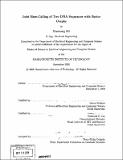Joint base-calling of two DNA sequences with factor graphs
Author(s)
Shi, Xiaomeng, Ph. D. Massachusetts Institute of Technology
DownloadFull printable version (3.930Mb)
Alternative title
Joint base-calling of 2 deoxyribonucleic acid sequences with factor graphs
Other Contributors
Massachusetts Institute of Technology. Dept. of Electrical Engineering and Computer Science.
Advisor
Muriel Médard and Desmond S. Lun.
Terms of use
Metadata
Show full item recordAbstract
The advent of DNA sequencing has revolutionized biological research by providing virtual blueprints of living organisms and offering insights into complicated biochemical processes. DNA sequencing is a process encompassing both chemical reactions and signal processing techniques to identify the order of chemical bases in a DNA molecule. In this thesis, we focus on the base-calling stage, during which base order is estimated from data collected through electrophoresis and florescence detection. In particular, we examine the possibility of jointly base-calling two superposed DNA sequences by applying the sum-product algorithm on factor graphs. This approach allows a single electrophoresis experiment to process two sequences, using the same quantity of reagents and machine hours as for a single sequence. A practical heuristic is first used to estimate the peak parameters, then separate those into two sequences (major/minor) by passing messages on a factor graph. Base-calling on the major alone yields accuracy commensurate with single sequence approaches, and joint base-calling provides results for the minor which, while being of lesser quality, incurs no additional cost and can be ultimately used in the genome assembly process.
Description
Thesis (S.M.)--Massachusetts Institute of Technology, Dept. of Electrical Engineering and Computer Science, 2008. Includes bibliographical references (p. 63-65).
Date issued
2008Department
Massachusetts Institute of Technology. Department of Electrical Engineering and Computer SciencePublisher
Massachusetts Institute of Technology
Keywords
Electrical Engineering and Computer Science.